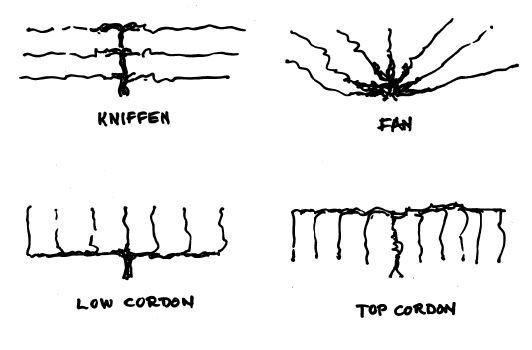Growing Grapes
Planting
Your plant may be either potted or bare root. If potted, remove from the pot. If there are twining roots tease them out so you can spread them evenly in the hole. Use the soil that you removed from the hole mixed with a handful or two of compost and a single handful of bloodmeal and bonemeal, or fish meal or alfalfa meal. Grapes grow best in a sweet soil (pH 6-7). Have your soil tested or buy a testing kit. If the soil is acidic (lower number) add agricultural lime. Grapes have wide spreading root systems so spread the lime a good distance from the trunk. A rule of thumb is to make the ground white with no actual thickness. Repeat every 6 years. Keep your plant well watered the first year but never soggy. A surface mulch will help keep the soil moist and retard weeds.
Pruning
Grapes naturally grow into trees and shrubs in order to reach the sun. Their purpose is to produce seed. Over the centuries people have chosen particular seedlings of several grape species that produce grapes that are larger, sweeter or that have superior properties for making wine.
In order to increase the size and sugar content of grapes vigorous pruning of the plants is practiced. Often a good portion of the plant is removed each year.
In order to prevent sap bleed we find fall is the best time to prune. November is ideal as the wood has hardened off and become dormant. Also, the leaves are gone, making the decision of where to prune easier. Spring pruning can be done as well, but the plants will bleed sap for several weeks, which can attract insects and fungi.
Growing Systems
Many types of systems for training and pruning grapes have developed over time. Most systems involve the use of posts and wires to expose the vines to the most sun and to secure the vines.
Though the systems may vary, the principle of pruning is to renew the plant each year by removing the canes that bore fruit the previous season and to use some of the new canes that have recently grown to provide fruit for the coming year.
When the old canes are removed a portion at the base of the cane, having one or two buds, is left to provide new canes for the following year. These remainders are referred to as renewal spurs.
Below are diagrams of some of the most popular forms of training systems. The growth habit of the particular grape (the cultivar) often influences the choice of system. For example the low cordon system is better suited to upright growing cultivars, whereas more prostrate cultivars are better suited to a high cordon system.


